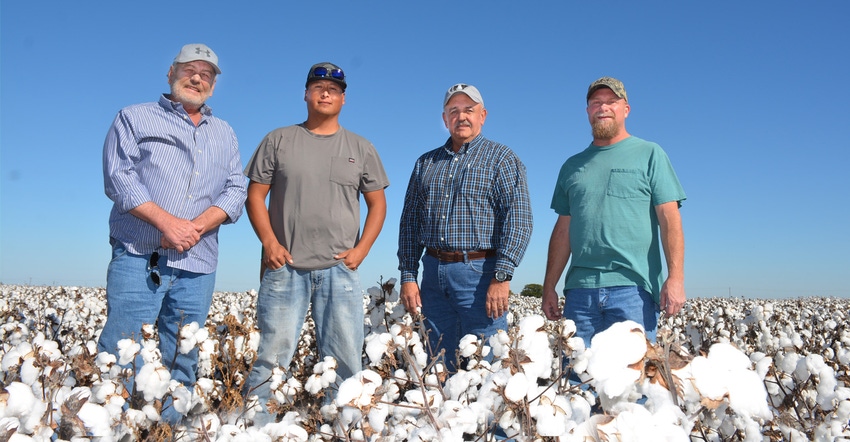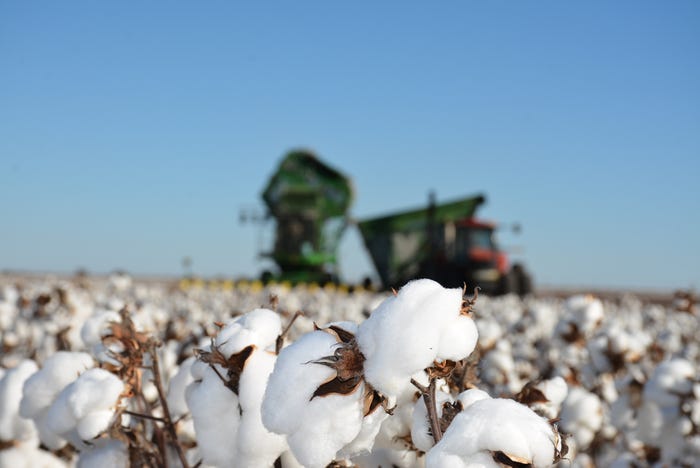
Despite drought, limited irrigation and only his second year returning to growing cotton, Lamb County grower Lynn Gullett is walking in high cotton, harvesting a career best in 2018— five plus to near five-bale cotton on multiple farms.
The secret to his success? “In farming, you try to do more things right than wrong because we all make a bad step here and there, but this year it just seems like everything worked,” says Gullett, who resides in Canyon but farms in Olton, Texas. “It was a lot of little bitty right things instead of a bunch of wrong things.”
One of his “right” choices he attributes to his success is crop rotation. Two years ago, he abandoned the practice of planting corn on corn and began to rotate cotton behind his corn acres. He also fractures the soil prior to planting.

Lamb County, Texas, cotton and corn grower Lynn Gullett, is walking in high cotton this year, making the highest yields of career.
“I’m only chiseling the soil about 11 inches deep but when it fractures, it might fracture on down 15 or 16 inches,” he says. “We fractured our soil really good. I think it was one of the first things that started a good crop.
“We always try to get a minimum of a 4-foot profile on our pre-watering and fracturing helped us get that.”
Seeding rate
Gullett, who confesses he’s still in the learning stages after being out of cotton for more than a decade, says while he planted a minimum seeding rate of 51,000 on his 40-inch rows in 2017, he increased the rate to 55,000 this year, an amount he may consider raising again in 2019.
“We made a decision early on to increase the plant population at a point when a lot of guys have started cutting back on their population because of the cost per acre of seed,” says Gullett’s crop consultant Randy Redinger, Nutrien Ag Solutions, Olton. “If you don't start right and start strong, you're battling the entire summer.”
Non-traditional
Gullett also chose to use some not-so-traditional methods on his cotton acres this year. For example, not applying pre-emergent herbicides. “Normally, we put a pre-emergent on, but the fields were so clean we decided to wait,” he says.
The use of yellow herbicides, under certain conditions, has been debated for years about the possibility of slight root pruning, says Redinger. “Not having a pre-emergent out there, we didn't have anything to hold the cotton back. It was our first year to do it — obviously, it was a big step but this being dicamba cotton, at the first flush of weeds, we dropped in there, sprayed it with dicamba and glyphosate and cleaned everything up. Then from that point on the cotton took off and kept going.”
It was apparent to Gullett in early summer, this was going to be a great crop. “You could tell it when it was to two-leaf or three leaves — it looked beautiful, everything just shanked up,” he says.
And compared to cotton emerging in the area, Gullett noticed his cotton was growing much faster.
“When you plant cotton, the first 72 hours the seed is in the ground is very critical to emergence,” says Redinger. “Then from that point on the first 40 days of the cotton crop are very important. If it starts strong, it finishes strong. And that's what we're seeing out here right now.”
Tools in the toolbox
In addition to ordering yearly soil samples to verify nutrient levels, Gullett says, like shovels were to row irrigation, soil probes are to his operation today. “You can look at a field and it might look good on top, but how much moisture do you have left? Do you have a foot or 4-foot of moisture?”
Carlos Sigala, Gullett’s field manager, spends a lot of time probing, information the two of them discuss when Gullett comes to the farm. “He’s already mapped out where he’s probed, how deep it is, and what we’ve got going on.
“We don't farm that much land and it allows Carlos more free time to probe. I can remember growing up, you didn't have time to do that kind of stuff. A lot of people would hire it done. A probe is real important.”
On average, Gullet says he puts out about seven-tenths of water a pass. “In the old days, we used to put on an inch, inch and a quarter. I think it's sometimes more important, especially in hot seasons during 100- degree weather, to get across it fast — forget about trying to push something down deep.”
A moisture probe takes out the guesswork. “If you pull up to the field and you’ve got a question and you don't know what to do, go out there and start probing and make a decision from there,” he adds.
Satellite pivots
Another tool Gullett credits to his success is satellites on his pivots. “Satellites are real important because you're able to control it so much better. An area that looks a little droughty, we can slow the sprinkler down and speed it back up on the tighter ground.”
See photo gallery, Career-best cotton yields
In fact, his field with the least amount of available irrigation out-produced his higher irrigation fields, making 13,000 pounds of corn and five-bale cotton.
“It's not always how much water you’ve got, it’s how you regulate it. That goes back to the satellite pivots. I’ve got a field with twice as much water and it doesn't produce any more than what this one did. I know it’s crazy. It’s just a lot of little things.”
Cover crops
One practice Gullett tried but did not have success with was a spring oat cover crop. He planted the cover to keep one of his fields from blowing but Redinger says it was nothing but trouble, in addition to costing him his spring moisture.
“We had trouble from day one with the oats getting established and then once we did get them up, it was time to terminate. That particular field, a circle of half corn, half cotton, is going to be his least productive,” Redinger says.
The cover crop was followed with corn. “Lynn’s made the decision it’s not for him to have a cover crop. We're going to use the corn residue as the cover. It’s not costing him anything and it's conserving moisture right now. That’s the advantage of the corn/cotton rotation on pivots.”

5-bale cotton, cotton harvest 18, lynn gullet
Redinger adds that while cover crops are beneficial in some situations, they are not for everyone, like in a droughty year such as the Olton area experienced in 2018, they may do more harm than good.
Racehorses
Gullett returned to the family farm in 1992 to farm alongside his father Jack Gullett, who passed away in 2015. When asked what his father would have thought of this year’s crop, Gullett laughingly replies, “Oh my gosh! He’d be going out and buying racehorses.”
Then turning to his landowner Brian Jefferies of Olton, who had pulled up to watch the cotton being stripped, Gullett says, “I was thinking if your dad could have seen this.”
“It’s absolutely amazing,” says Jefferies, who inherited the land from his late father John Jefferies. “Over the years dad and grandpa took care of it and then people they got to farm it afterward have taken care of it. It’s one of the cleanest places around in my opinion. I just couldn't be prouder.”
About the Author(s)
You May Also Like






